Maintaining a cemetery can be one of the toughest applications for any mower. It not only has to maneuver in between and around headstones, but cemetery grounds are notoriously bumpy as graves deteriorate over time. When the cemetery is located in Montana where winters can be difficult, having mowers that can do double-duty snow removal is important as well.
Finding a mower that was both agile and flexible became a high priority for Lee Stadtmiller soon after he became manager of the Mountview Cemetery in Billings. The former funeral director was well acquainted with the cemetery, but not with all of the nuances associated with maintaining it.
“My predecessor employed a fleet of five belly-mount mowers because the tractor platform could accommodate several attachments,” he relates. “The machines, though, were not very agile and the belly-mount configuration left a lot of work for push mower operators. In fact, it took 12 working days to completely mow the cemetery. You have to understand, they had plenty of ground to cover. The cemetery is located on 65 acres and features approximately 2 million square feet of turf and more than 23,000 grave sites.”
Paying The Price
When Stadtmiller was hired 14 years ago, one of the first things he did that fall was to fertilize the grounds, something cemeteries rarely if ever did, he remarks. “I paid the price,” he adds. “Next spring, five days before Memorial Day, the grass jumped and there was no way our mowing crew could keep up. We had mowed the cemetery three days prior to Memorial Day, but on the day itself, it looked like it hadn’t been mowed in two weeks.
“My boss wasn’t happy and neither were several people within the community,” Stadtmiller continues. “I quickly tried out several different mowers, looking for something that was as flexible as the current mowers but more agile.”
Enter the Walker Mowers. The cemetery replaced the five belly-mount mowers with four Walker Mower diesels. Today, equipped with four differentsized mulching and side-discharge decks, the machines have reduced mowing time from 12 days to three, and they’ve virtually eliminated push mowers and seriously reduced string-line trimming.
The newest addition is the Model Super B. Stadtmiller says his next one will be another Super B, thanks to its speed and slightly higher profile that improves operator visibility. A debris blower, blade, snow thrower and broom attachment provide the same year-round flexibility that accompanied the previous mowers.
Mowing Science
Mountview Cemetery is comprised of two cemeteries: an older one called Billings and the newer Mountview on an adjacent site. The primary difference between the two, not counting age (in the Billings cemetery, some graves date back to 1882), is planning. Headstones and markers in the new section are required to be granite, and they are evenly spaced so mower operators can go up one row, mow around three corners of a stone along the way and then return on the other side mowing in a straight line, catching the final corner.
The process is slightly more problematic in the Billings section where stones of all different configurations and composition are placed rather haphazardly. But mowing was only one challenge the new cemetery manager faced.
“When I came to Montana in the late 1970s, caskets were still being delivered to funeral homes in wood boxes. These same boxes were also used as the casket’s outer container. Over time, both the casket and wood box would deteriorate, creating a sink hole. Raising the sunken grave sites was a laborious process that involved removing the sod, hand tamping the grave, filling it in, and then replacing the sod. It was all a cemetery crew could do to raise three graves in a day.
“Initially I had 2,000 graves that needed to be raised,” Stadtmiller continues. “We are not talking about slight divots either, but holes in which one could hide a mower. Since then, we’ve raised somewhere between 9,000 and 10,000 graves. Although the cemetery grounds are far more level than when I came here, they’re still very tough on mowers. You can see the floating deck on the Walker Mowers constantly going up and down to accommodate bumps and dips. Despite the punishment, we schedule a mower change-out every 3,000 hours, but they usually get somewhere between 3,500 and 4,000 hours before we actually trade them in.”
Full Schedule
In addition to mowing and raising graves, the cemetery’s four full-time employees operate and maintain the irrigation system, prepare graves, attend services, and help maintain some adjacent properties owned by the city. As manager, Stadtmiller oversees the maintenance crew, which also includes four seasonal employees, and then, in his words, “does a little of everything else.”
“I try to comfort grieving families, sell grave sites, and talk people through our website,” he explains. “People can locate friends’ and relatives’ graves right on our website, but not everyone is comfortable with computers so I often spend some phone time with them.”
When asked how someone gets into this rather unusual line of work, Stadtmiller says it was more of a calling for him than anything else. “I see people during the most difficult times of their lives, and if I can be of some comfort and help to them, that is rewarding to me. Billings is not a big city, either, and I get to know many of our customers and interact with them as they try to get their lives back to normal.”
He notes that the cemetery business has changed dramatically, even within the 14 years he has been Mountview’s manager. “Cremation has extended the cemetery’s life. It now accounts for roughly 60 percent of our burials, giving us space to accommodate 80,000 burials or more in the future.”
In the meantime, maintenance work goes on all year long and will continue to go on long after Stadtmiller retires. When a customer buys a grave site, the cost also includes maintaining the site in perpetuity








 Site Search
Site Search



